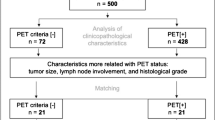Abstract
Purpose
To investigate 18F-FDG PET/CT feature of pancreatic adenosquamous carcinoma (PASC) in contrast with conventional pancreatic ductal adenocarcinoma (PDAC), and its correlation with pathological findings.
Patients and methods
Patients with PASC or PDAC confirmed by surgical pathology, who underwent FDG PET/CT scanning before surgical resection, were retrospectively studied. PASC group and conventional PDAC group included 13 and 104 patients, respectively. Delayed phase of PET/CT scanning was performed in 12 patients with PASC and 99 with PDAC. Maximum standardized value (SUVmax) was measured, and the mean retention index (RI) was calculated by ([PET120min SUVmax]–[PET 60min SUVmax]) ÷ PET 60min SUVmax × 100%.
Results
On PET/CT, all lesions of PASC group showed intense FDG uptake, and the SUVmax were significantly higher than the lesions of conventional PDAC group both on the early [10.43 ± 5.10 (4.37–24.00) vs. 7.31 ± 3.86 (1.93–21.08), P = 0.011] and delayed phase [13.29 ± 6.04 (5.72–28.16) vs. 8.84 ± 5.14 (1.92–27.58), P = 0.005]. On the delayed phase, all lesions of PASC group had increased SUVmax with positive RI value (27.04% ± 8.87%, 7.14–39.27%). For conventional PDAC group, 81 lesions had increased SUVmax with positive RI value (27.25% ± 19.10%, 1.09–104.49%), while eighteen (18.18%) lesions of PDAC group had slightly decreased SUVmax, and their RI value were negative (− 11.35% ± 13.50%, − 43.17 to − 0.14%). The proliferative index (Ki-67) of lesions of PASC group was positively correlated with both the early (P = 0.034, r = 0.671) and delayed SUVmax (P = 0.019, r = 0.721). The RI value of lesions with adjacent organ invasion in PASC group was significantly higher than those without invasion (33.25% ± 4.92% vs. 20.83% ± 7.49%, P = 0.007).
Conclusion
PASC has more intense FDG uptake than conventional PDAC both on early and delayed phase. RI value of PASC was positive. Negative RI value may be helpful for differentiating PDAC from PASC. SUVmax and RI value may be helpful for prediction of its malignancy and invasion.


Similar content being viewed by others
References
Boyd CA, Benarroch-Gampel J, Sheffield KM, et al. (2012) 415 patients with adenosquamous carcinoma of the pancreas: a population-based analysis of prognosis and survival. J Surg Res 174(1):12-19. https://doi.org/10.1016/j.jss.2011.06.015
Madura JA, Jarman BT, Doherty MG, et al. (1999) Adenosquamous carcinoma of the pancreas. Arch Surg 134(6):599-603. https://doi.org/10.1001/archsurg.134.6.599
Aranha GV, Yong S, Olson M. (1999) Adenosquamous carcinoma of the pancreas. Int J Pancreatol. 26(2):85-91. https://doi.org/10.1007/BF02781735
Imaoka H, Shimizu Y, Mizuno N, et al. (2014) Clinical characteristics of adenosquamous carcinoma of the pancreas: a matched case-control study. Pancreas. 43(2):287-290. https://doi.org/10.1097/MPA.0000000000000089
Okabayashi T, Hanazaki K. (2008) Surgical outcome of adenosquamous carcinoma of the pancreas. World J Gastroenterol. 14(44):6765-6770. https://doi.org/10.3748/wjg.14.6765
Izuishi K, Takebayashi R, Suzuki Y. (2010) Adenosquamous Carcinoma of the Pancreas. Clin Gastroenterol Hepatol 8(4):40-40. https://doi.org/10.1016/j.cgh.2009.11.020
Jiang L, Nie H, Zhu L, et al. (2017) Adenosquamous Carcinoma of the Pancreas Demonstrated on 18F-FDG PET/CT Imaging. Clin Nucl Med 42(3):206-208. https://doi.org/10.1097/RLU.000000000001535
Borazanci E, Millis S Z, Korn R, et al. (2015) Adenosquamous carcinoma of the pancreas: Molecular characterization of 23 patients along with a literature review. World J Gastrointest Oncol 7(9):132-140. https://doi.org/10.4251/wjgo.v7.i9.132
Hsu JT, Chen HM, Wu RC, et al. (2008) Clinicopathologic features and outcomes following surgery for pancreatic adenosquamous carcinoma. World J Surg Oncol 6(1):95-100. https://doi.org/10.1186/1477-7819-6-95
Smoot RL, Zhang L, Sebo TJ, Que FG. (2008) Adenosquamous carcinoma of the pancreas: a single-institution experience comparing resection and palliative care. J Am Coll Surg 207 (3):368-370. https://doi.org/10.1016/j.jamcollsurg.2008.03.027
Toshima F, Inoue D, Yoshida K, et al. (2016) Adenosquamous carcinoma of pancreas: CT and MR imaging features in eight patients, with pathologic correlations and comparison with adenocarcinoma of pancreas. Abdominal Radiology, 41(3):508-520. https://doi.org/10.1007/s00261-015-0616-4
Yin Q, Wang C, Wu Z, et al. (2013) Adenosquamous Carcinoma of the Pancreas: Multidetector-Row Computed Tomographic Manifestations and Tumor Characteristics. J Comput Assist Tomogr, 37(2):125-133. https://doi.org/10.1097/rct.0b013e31827bc452
Ding Y, Zhou J, Sun H, et al. (2013) Contrast-enhanced multiphasic CT and MRI findings of adenosquamous carcinoma of the pancreas[J]. Clin Imaging, 37(6):1054-1060. https://doi.org/10.1016/j.clinimag.2013.08.002
Yang F, Jin C, Long J, et al. (2009) Solid pseudopapillary tumor of the pancreas: a case series of 26 consecutive patients. Am J Surg 198(2):210-215. https://doi.org/10.1016/j.amjsurg.2008.07.062
Tang LH, Aydin H, Brennan MF, et al. (2005) Clinically Aggressive Solid Pseudopapillary Tumors of the Pancreas:a report of two cases with components of undifferentiated carcinoma and a comparative clinicopathologic analysis of 34 conventional cases. Am J Surg Pathol 29(4):512-519. https://doi.org/10.1097/01.pas.0000155159.28530.88
Dong A, Wang Y, Dong H, et al. (2013) FDG PET/CT Findings of Solid Pseudopapillary Tumor of the Pancreas With CT and MRI Correlation. Clin Nucl Med 38(3):118-124. https://doi.org/10.1097/RLU.0b013e318270868a
Nakagohri T, Kinoshita T, Konishi M, et al. (2008) Surgical outcome of solid pseudopapillary tumor of the pancreas. J Hepatobiliary Pancreat Surg 15(3):318-321. https://doi.org/10.1007/s00534-007-1264-z
Song JY, Lee YN, Kim YS, et al. (2015) Predictability of preoperative 18F-FDG PET for histopathological differentiation and early recurrence of primary malignant intrahepatic tumors. Nucl Med Commun 36(4):319-27. https://doi.org/10.1097/MNM.0000000000000254
Baek YH, Lee SW, Jeong YJ, et al. (2015) Tumor-to-muscle ratio of 8F-FDG PET for predicting histologic features and recurrence of HCC. Hepatogastroenterology 62(138):383-388. https://doi.org/10.5754/hge14873
Acknowledgements
This study is not supported by any institution.
Author information
Authors and Affiliations
Corresponding author
Ethics declarations
Conflict of interest
The authors have no potential conflict of interest to declare.
Additional information
Publisher's Note
Springer Nature remains neutral with regard to jurisdictional claims in published maps and institutional affiliations.
Rights and permissions
About this article
Cite this article
Su, W., Zhao, S., Chen, Y. et al. 18F-FDG PET/CT feature of pancreatic adenosquamous carcinoma with pathological correlation. Abdom Radiol 45, 743–749 (2020). https://doi.org/10.1007/s00261-019-02393-6
Published:
Issue Date:
DOI: https://doi.org/10.1007/s00261-019-02393-6




